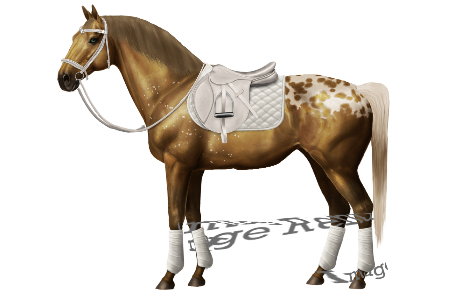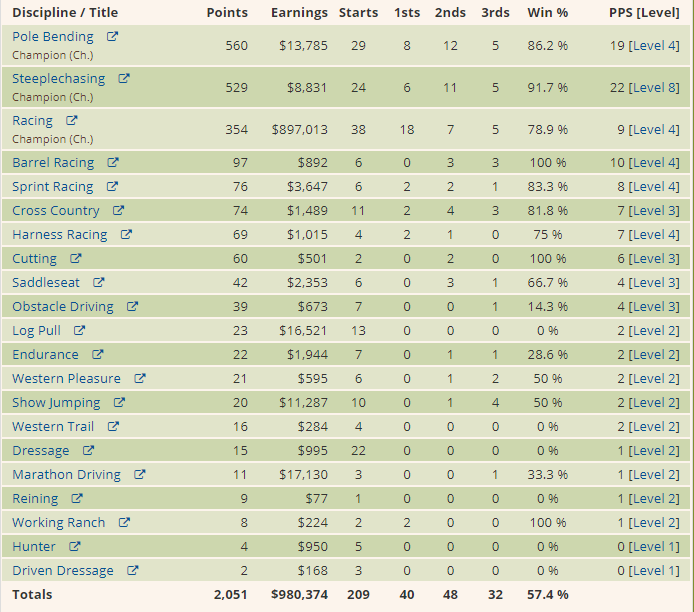Community Forum
Horse World Online
Breed horses and ponies, raise your foals, and train the next champion in this exciting and realistic online horse breeding game.
The new layout is in beta testing and we're inviting you to help us try it out! Click here to read the announcement post for details.
Evaluating Stud Quality - A Guide to Picking the Right Stallion
2 posts
• Page 1 of 1
-
Silverine

- Posts: 1795
- Joined: Wed May 17, 2017 3:13 am
- Visit My Farm
Evaluating Stud Quality - A Guide to Picking the Right Stallion
Post by Silverine »
Silverine's Guides - Quick Links
Step-by-Step Beginner Guide
Feeding For Weight And Temperament
Quest Breeding Guide
Discipline Potential Evaluation
Evaluating Stud Quality - You are here.
Step-by-Step Beginner Guide
Feeding For Weight And Temperament
Quest Breeding Guide
Discipline Potential Evaluation
Evaluating Stud Quality - You are here.
Evaluating Stud Quality
When looking for an outside stud from the market there are a lot of things to consider. I've created this guide to help you find the best stallion for your mare.Breed
Purebred vs Crossbreed
There are few benefits to being a purebred on HWO. In fact, the only thing that purebreds can do that crossbreeds can't is enter breed-specific shows. So unless you want to maintain and improve a certain breed there is no reason to choose a purebred stud over a cross simply because it is purebred. One caveat is that if you are breeding offspring for sale, purebreds generally fetch a higher price than crossbreeds.
Of course, some breeds are more popular than others. The current most popular breeds are Arabians and Thoroughbreds. There are some niche markets for other breeds such as Deliboz and Estonian Native, but they can be more difficult to break in to.
Certain crossbreeds can be valuable if they are used in a breed recipe. Breed recipes are crosses that can be used to breed new breeds. You can find more information on creating new breeds here.
Stud Price
When you're first starting out, the price to breed with a stallion is probably the most prohibitive part of the breeding process. However, a high stud price does not mean that a stallion is good quality. Players can put a stallion at stud for any price they want. Some players put stallions up for large amounts because they think breeding to the stallion is worth that much money, while others do it simply because they can, or because they don't want a large number of people breeding to their stallion. But don't turn to the stud price to determine a stallion's quality.
Take, for example, these two Arabian stallions:


The first stallion is asking a stud price of $25,000. Quite the princely sum. And on first glance it seems like he deserves it. He has an HGP of 70,146 with four golden stats and two greens. Even his two uncolored stats have positive comments. And his conformation is pretty good, too. Overall he looks like $25,000 isn't a bad asking price.
Until you consider the second stallion. The second stallion is at stud for $1. He has an HGP of 71,163 - higher than the first stallion - with five golden stats and one green. His uncolored stats are also positive and his conformation is better in some areas than the first stallion. With all of this considered, if you are breeding for stats and competition ability there is no reason to breed with the $25,000 stallion over the $1 stallion.
So don't assume that a high stud price means a better stallion.
Competition Ability
Horse Genetic Potential (HGP) and Conformation
If you're looking for a stallion that will sire a good competition horse the most important thing to look at is his conformation, followed by his HGP. Before looking for a stallion you will want to decide on what discipline you're looking to compete in. It's a good idea to choose something your mare is good at so that the foal will have compatible parents.
As an example we will look at this mare, who is bred for and excels at sprint racing. She has excellent conformation for speed with a score of 59, and complimentary conformation in strength and agility (20 for both) - the three stats judged in sprint racing competitions. Looking at her breeder's report, she has a gold speed comment, a positive comment for agility, and a neutral comment for strength. A good stallion for her will ideally have conformation scores and breeder's report comments that are equal to or better than her own in speed, strength, and agility.
Now let's take a look at two of my stallions - stallion 1 and stallion 2. Stallion 1 has a total HGP of 44,459 with two gold comments. Stallion 2 has a total HGP of 54,863 with one gold comment and three green comments. Going solely on HGP and breeder's report a lot of people would choose stallion 2. But let's look closer.
I said before that my mare was bred for racing and we want a stallion with good speed, strength, and agility. Stallion 1's two gold comments are in speed and agility, and his strength comment is positive. Meanwhile stallion 2 only has a green agility comment, and neither his speed nor his strength comment are colored (though both are positive).
The nail in the coffin for stallion 2 is his conformation. His speed conformation score is a measly 12. You can't get a much lower conformation score than that. His strength and agility scores are only slightly better at 20 and 21. If we look back at stallion 1 we see that he has an amazing speed conformation score of 64 - lightyears better than stallion 2! His agility score is also significantly higher at 32 and his strength score is marginally better at 23. So while at first glance we might be inclined to choose stallion 2, if we really want a foal that excels we would be better off to breed our mare to stallion 1.
Championships and Competition Record
Stallions with championships are often more attractive to other players than stallions without. However, having a championship does not mean that a stallion is good in competition. It is very easy to earn championships on HWO, especially low-level championships. If you are looking to breed a skilled foal it is a good idea to evaluate the stallion thoroughly before breeding to it rather than breeding with it simply because it has a pretty championship ribbon.
Rather than taking a championship at face value, look at a stallion's competition record. Here is an example:

This horse has entered a lot of competitions, but he hasn't performed well in all of them. Check out the Win % column. Looking there we can see that he was entered into 13 Log Pull competitions and placed in none of them. So this is not a stallion we would want to use if we were trying to breed a competitive log puller. On the other hand he has started in 24 Steeplechase events and gotten 3rd or better in 91.7% of them. So he'd be a good bet to sire a foal that shows well in steeplechase. There is a bunch of other information we can gain from looking at this table, but those are the important points for now.
Coat Color
A final consideration when choosing a stallion is color. This can be a non-factor: color does not affect a horse's competition ability or its HGP or conformation. So it's only important if you care about it. If you do care about it, here are a few things to consider:
-A gray horse has an at least 50% chance to throw a gray foal. If you breed two grays together that chance jumps to 75%. If a horse has two gray parents there is a 25% chance that the horse has a 100% chance to throw gray foals. (Yes, genetics can be confusing. Sorry.)
-Two red-based, non-gray horses when bred together will always have a red-based foal. (Red base is chestnut. So any horse that is chestnut, palomino, cremello, buff, palomino pearl, or any variation thereof.)
-Two black horses will never throw a bay or a brown.
-Two brown horses will never throw a bay.
If you would like to know more about color genetics, check out Totina's wonderful guide found here.

Silverine's Guides - Quick Links
Step-by-Step Beginner Guide
Feeding For Weight And Temperament
Quest Breeding Guide
Discipline Potential Evaluation
Evaluating Stud Quality
-
Cookie.Stables
- Posts: 79
- Joined: Fri May 08, 2020 4:30 pm
- Visit My Farm
Re: Evaluating Stud Quality - A Guide to Picking the Right Stallion
Post by Cookie.Stables »
Thank you for the information!
2 posts
• Page 1 of 1
Jump to
- General Discussion
- ↳ Announcements
- ↳ Weekly Development Updates
- ↳ General Chit Chat
- ↳ Contests
- ↳ What Colour Is My Horse?
- ↳ Comments and Suggestions
- ↳ Suggestions Archive
- ↳ Breeding Communities
- ↳ Farm Logs
- Marketplace
- ↳ Horses for Sale
- ↳ Stallions at Stud
- Knowledgebase & Guides
- ↳ Gameplay Questions & Help
- ↳ Guides & How To
- Technical
- ↳ Change Log v3
- Guest Discussions
- ↳ Public Questions & Answers
